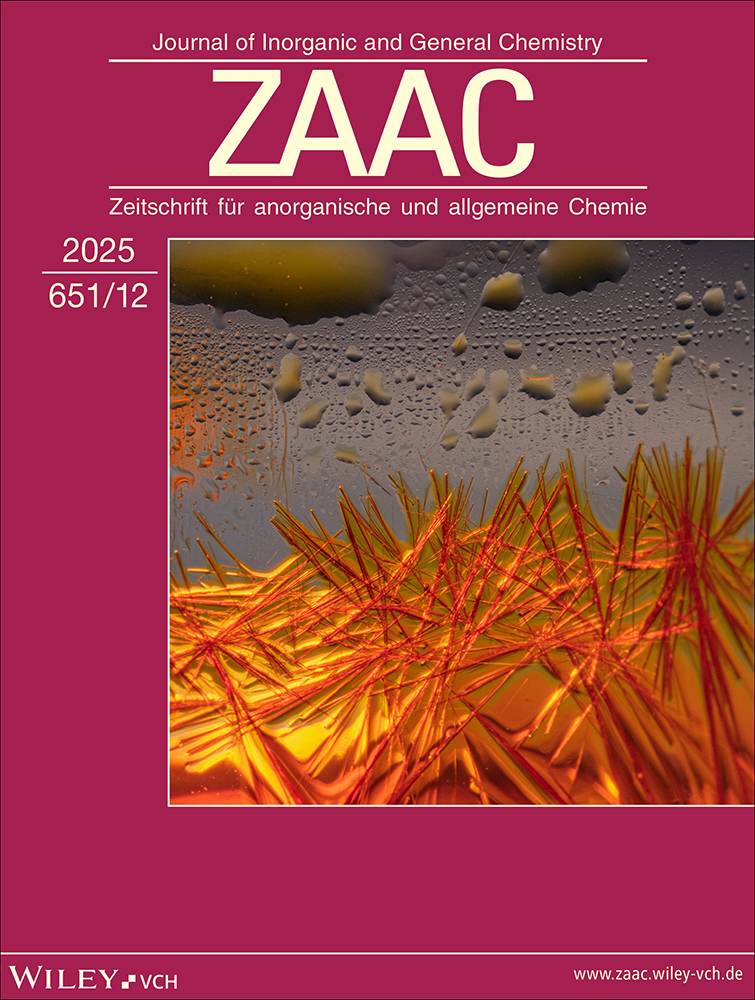Synthese, Kristallstrukturen und Magnetismus von (Hg6As4)[MoCl6]Cl, (Hg6As4)[TiCl6]Cl und (Hg6As4)[TiBr6]Br
Abstract
de(Hg6As4)[MoCl6]Cl wird aus Hg2Cl2, Hg, As und MoCl4 in evakuierten, geschlossenen Glasampullen im Temperaturgefälle 450 → 400 °C in Form tiefroter, würfelförmiger Kristalle erhalten. (Hg6As4)[TiCl6]Cl und (Hg6As4)[TiBr6]Br entstehen ebenfalls in geschlossenen, evakuierten Ampullen aus Hg2X2 (X = Cl, Br), Hg, As und Ti-Metall bei 275 °C bzw. 245 °C in Form dunkelgrüner bzw. schwarzer Kristalle. Alle drei Substanzen sind luft- und lichtempfindlich und kristallisieren isotyp (kubisch, Pa 3, a = 1207,8(4) pm für (Hg6As4)[MoCl6]Cl, a = 1209,4(3) pm für (Hg6As4)[TiCl6]Cl, a = 1230,9(3) pm für (Hg6As4)[TiBr6]Br, Z = 4). Die Strukturen bestehen aus einem dreidimensional verknüpften Hg–As-Gerüst, das aus As2-Gruppen (As–As-Abstand im Mittel 242 pm) aufgebaut ist, die jeweils über sechs Hg-Atome mit sechs weiteren As2-Gruppen verbunden sind. Auf diese Weise entstehen in dem polykationischen (Hg6As4)-Gerüst Hohlräume, deren eine, größere Sorte mit oktaederförmigen [MoCl6]3–, [TiCl6]3– bzw. [TiBr6]3–-Ionen und deren zweite, kleinere Sorte mit diskreten Halogenid-Ionen gefüllt ist. Die magnetischen Eigenschaften der beiden Ti-haltigen Substanzen lassen sich mit einem d1-Paramagnetismus und der Berücksichtigung der Spin-Bahn-Kopplung nach Figgis deuten. Für die Vertreter dieses Strukturtyps ergibt sich die ionische Formulierung (Hg6Y4)4+[MX6]3–X– (Y = As, Sb; M = Sb3+, Bi3+, Mo3+, Ti3+; X = Cl, Br).
Abstract
enPolycationic Hg–As Frameworks with Trapped Anions. II Synthesis, Crystal Structure, and Magnetism of (Hg6As4)[MoCl6]Cl, (Hg6As4)[TiCl6]Cl, and (Hg6As4)[TiBr6]Br
(Hg6As4)[MoCl6]Cl is obtained by reaction of Hg2Cl2, Hg, As, and MoCl4 in closed, evacuated glass ampoules in a temperature gradient 450 → 400 °C in form of dark red cubelike crystals. (Hg6As4)[TiCl6]Cl and (Hg6As4)[TiBr6]Br are also formed in closed, evacuated ampoules from Hg2X2 (X = Cl, Br), Hg, As, and Ti metal at 275 °C and 245 °C in form of dark green and black crystals, respectively. All three compounds are air and light sensitive. They crystallize isotypically (cubic, Pa 3, a = 1207.8(4) pm for (Hg6As4)[MoCl6]Cl, a = 1209.4(3) pm for (Hg6As4)[TiCl6]Cl, a = 1230.9(3) pm for (Hg6As4)[TiBr6]Br, Z = 4). The structures consist of a three-dimensionally connected Hg–As framework which is made up of As2 groups (As–As distance averaged 242 pm) each connected via six Hg atoms to six neighbouring As2 groups. There are two cavities of different size in the polycationic framework. The bigger cavity is filled with [MoCl6]3–, [TiCl6]3–, and [TiBr6]3– ions of nearly ideal octahedral shape, the smaller cavity with discrete halide ions. The magnetic properties of the two Ti containing compounds are in accordance with a d1 paramagnetism. The temperature dependence and the magnitude of the magnetic moment can be interpreted with consideration of the spin-orbit coupling. The so far known representatives of this structure type can be characterised by the ionic formula (Hg6Y4)4+[MX6]3–X– (Y = As, Sb; M = Sb3+, Bi3+, Mo3+, Ti3+; X = Cl, Br).




